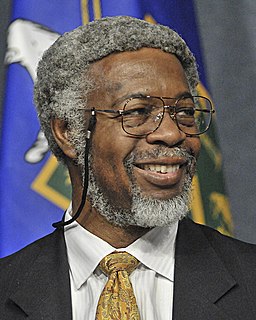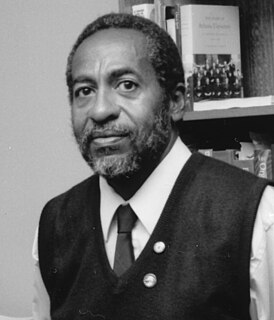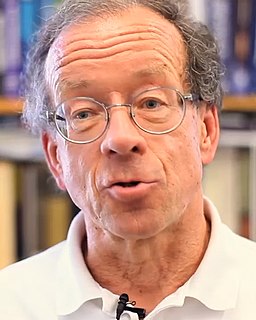Related Research Articles

Ali Javan was an Iranian-American physicist and inventor. He was the first to propose the concept of the gas laser in 1959 at the Bell Telephone Laboratories. A successful prototype, constructed by him in collaboration with W. R. Bennett, Jr., and D. R. Herriott was demonstrated in 1960. His other contributions to science have been in the fields of quantum physics and spectroscopy.
Terrence Joseph Sejnowski is the Francis Crick Professor at the Salk Institute for Biological Studies where he directs the Computational Neurobiology Laboratory and is the director of the Crick-Jacobs center for theoretical and computational biology. He has performed pioneering research in neural networks and computational neuroscience.

Philip Morrison was a professor of physics at the Massachusetts Institute of Technology (MIT). He is known for his work on the Manhattan Project during World War II, and for his later work in quantum physics, nuclear physics and high energy astrophysics.
Roberto Daniele Peccei was a theoretical particle physicist whose principal interests lay in the area of electroweak interactions and in the interface between particle physics and physical cosmology. He was most known for formulating the Peccei–Quinn theory, which attempts to resolve the strong CP problem in particle physics.

Sylvester James Gates Jr., known as S. James Gates Jr. or Jim Gates, is an American theoretical physicist who works on supersymmetry, supergravity, and superstring theory. He retired from the physics department and Center for Fundamental Physics at the University of Maryland College of Computer, Mathematical, and Natural Sciences in 2017, and he is now the Brown Theoretical Physics Center Director, the Ford Foundation Professor of Physics, Affiliate Professor of Mathematics, and Watson Institute for International and Public Affairs Faculty Fellow at Brown University. He was a University of Maryland Regents Professor and served on former President Barack Obama's Council of Advisors on Science and Technology.
Jeffrey Goldstone is a British theoretical physicist and an emeritus physics faculty member at the MIT Center for Theoretical Physics.
Mehran Kardar is an Iranian born physicist and professor of physics at the Massachusetts Institute of Technology (MIT), and co-faculty at the New England Complex Systems Institute (USA). He received his B.A. in physics from the University of Cambridge in 1979, and obtained his Ph.D. from MIT in 1983. Kardar is particularly known for the Kardar–Parisi–Zhang (KPZ) equation in theoretical physics, which has been named after him and collaborators. He was awarded a Guggenheim Fellowship in 2001.
Boris Leonidovich Altshuler is a professor of theoretical physics at Columbia University. His specialty is theoretical condensed matter physics.
Anthony Philip French was a British professor of physics at the Massachusetts Institute of Technology. He was born in Brighton, England. French was a graduate of Cambridge University, receiving his B.A. in 1942 and Ph.D. in 1948, both in physics. In 1942, he began working on the British effort to build an atomic bomb at the Cavendish Laboratory. By 1944, Tube Alloys had been merged with the American Manhattan Project and he was sent to Los Alamos.
Herman Feshbach was an American physicist. He was an Institute Professor Emeritus of physics at MIT. Feshbach is best known for Feshbach resonance and for writing, with Philip M. Morse, Methods of Theoretical Physics.
Robert Loren Jaffe is an American physicist and the Jane and Otto Morningstar Professor of Physics at the Massachusetts Institute of Technology (MIT). He was formerly director of the MIT Center for Theoretical Physics.

Katepalli Raju Sreenivasan is an aerospace scientist, fluid dynamicist and applied physicist whose research includes physics and applied mathematics. He studies turbulence, nonlinear and statistical physics, astrophysical fluid mechanics, and cryogenic helium. He was the dean of engineering and executive vice provost for science and technology of New York University. Sreenivasan is also the Eugene Kleiner Professor for Innovation in Mechanical Engineering at New York University Tandon School of Engineering, and a professor of physics and mathematics professor at the New York University Graduate School of Arts and Science and Courant Institute of Mathematical Sciences.
Lawrence Paul Horwitz is an American/Israeli physicist and mathematician who has made contributions in particle physics, statistical mechanics, mathematical physics, theory of unstable systems, classical chaos and quantum chaos, relativistic quantum mechanics, quantum field theory, general relativity, representations of quantum theory on hypercomplex Hilbert modules, group theory and functional analysis and stochastic theories of irreversible quantum evolution.

William Samuel Bialek is a theoretical biophysicist and a professor at Princeton University and The Graduate Center, CUNY. Much of his work, which has ranged over a wide variety of theoretical problems at the interface of physics and biology, centers around whether various functions of living beings are optimal, and whether a precise quantification of their performance approaches limits set by basic physical principles. Best known among these is an influential series of studies applying the principles of information theory to the analysis of the neural encoding of information in the nervous system, showing that aspects of brain function can be described as essentially optimal strategies for adapting to the complex dynamics of the world, making the most of the available signals in the face of fundamental physical constraints and limitations.

Frederick Duncan Michael Haldane, known as F. Duncan Haldane, is a British-born physicist who is currently the Sherman Fairchild University Professor of Physics at Princeton University. He is a co-recipient of the 2016 Nobel Prize in Physics, along with David J. Thouless and J. Michael Kosterlitz.
Michael J. Shelley is an American applied mathematician who works on the modeling and simulation of complex systems arising in physics and biology. This has included free-boundary problems in fluids and materials science, singularity formation in partial differential equations, modeling visual perception in the primary visual cortex, dynamics of complex and active fluids, cellular biophysics, and fluid-structure interaction problems such as the flapping of flags, stream-lining in nature, and flapping flight. He is also the co-founder and co-director of the Courant Institute's Applied Mathematics Lab.

Ronald Elbert Mickens is an American physicist and mathematician who is the Fuller E. Callaway Professor of Physics at Clark Atlanta University. His research focuses on nonlinear dynamics and mathematical modeling, including modeling epidemiology. He also has an interest in the history of science and has written on the history of black scientists. He is a fellow of the American Physical Society and served as the historian of the National Society of Black Physicists. He has made significant contributions to the theory of nonlinear oscillations and numerical analysis.

Arto V. Nurmikko, a native of Finland, is a L. Herbert Ballou University Professor of Engineering and Physics at Brown University. He received his degrees from University of California, Berkeley, with postdoctoral stays at MIT and Hebrew University. Professor Nurmikko conducts research in neuroengineering, brain sciences, nanophotonics and microelectronics, especially for the translation of device research to new technologies in biomedical, life science, and photonics applications.

David Horn is a Professor (Emeritus) of Physics in the School of Physics and Astronomy at Tel Aviv University (TAU), Israel. He has served as Vice-Rector of TAU, Chairman of the School of Physics and Astronomy and as Dean of the Faculty of Exact Sciences in TAU. He is a fellow of the American Physical Society, nominated for "contributions to theoretical particle physics, including the seminal work on finite energy sum rules, research of the phenomenology of hadronic processes, and investigation of Hamiltonian lattice theories".
References
- ↑ "APS Fellow Archive". American Physical Society. (search on year=1981 and institution=New York University)